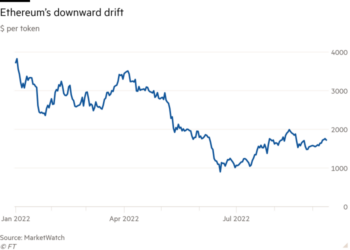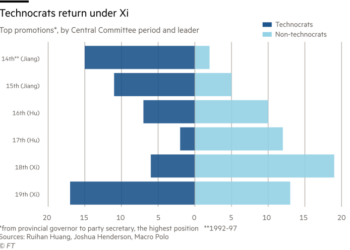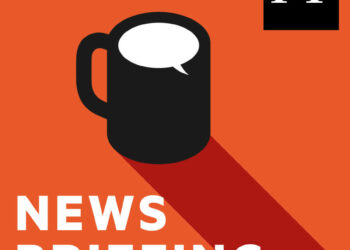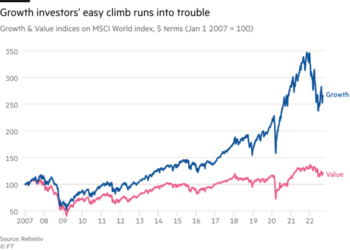It is expensive to be an avid American fan of costume drama. The first episode of Julian Fellowes’ series The Gilded Age was broadcast on the subscription service HBO Max this week, while Downton Abbey, his earlier one, is available on Amazon Prime. In March, Netflix will show the second series of Bridgerton for subscribers who pay $15.50 per month.
The cost of needing to pay for a plethora of streaming video services to watch all you want is starting to hurt Netflix, which pioneered streaming and has 222m subscribers globally. Its shares fell 20 per cent last week after it disclosed that its growth in new subscribers has slowed as competition bites.
Netflix is not the only one in the doldrums, having benefited from people paying for home entertainment in the pandemic. Peloton, the home fitness group that charges $2,495 for its flagship exercise bicycle and another $39 a month for full access to online classes, was this week attacked for its “listless strategy” by an activist investor that wants its chief executive to resign.
Is this the coming of subscription fatigue, the long-awaited phenomenon of people getting tired of paying monthly fees for everything from streaming video and audio to razor blades and home-delivered vegetable boxes? With the average UK subscriber household paying £620 for services last year, according to Barclaycard Payments, surely something has to give?
Some doubt whether people are tiring. “Subscription fatigue is not happening any time soon, at least not in entertainment,” says Michael Wolf, chief executive of Activate, the US consulting firm. It estimates that the average US paid video streaming subscriber had 4.4 subscriptions last year, and predicts that this will rise to 5.8 by 2025, despite Netflix’s travails.
But I admit to some confusion. As well as the Apple TV Plus subscription I took to watch The Morning Show, and have not got around to cancelling, there is my underused membership of the local lido (it has been chilly) and a small fee charged monthly by Amazon Japan, the reason for which I have forgotten.
It is hard to keep track of all this stuff and not always easy to decide whether it might come in useful at some point. Do I want a monthly subscription to Lonely Planet, in case I can travel again? Why is my family signed up to Dropbox as well as iCloud and should I fix it? Will I ever escape Microsoft 365?
Then there is the tiresome behaviour of companies that make it a lot easier to join than to leave. Virgin Media, for example, has a broad array of broadband and television upgrades available on its website, but perish the thought that you want to cancel or to spend less. That requires a long wait to get through to its call centre, or writing Virgin a letter and posting it.
Since Dollar Shave Club disrupted Gillette by selling razors cheaply on subscription and digital advertising failed to provide the hoped-for cushion for free media content, every company seems to crave subscribers (including the Financial Times). So do many writers and creators, thanks to platforms such as Patreon and Substack, and it would feel remiss not to support some of them.
The world’s lurch towards subscriptions is not bad in itself. Matthew Ball, a venture capitalist, once pointed out that, “to claim that consumers have ‘subscription fatigue’ is to say that they have ‘spending fatigue’”. People always had to decide whether to buy things or not and whether those things were necessities or luxuries: all that has changed is that they subscribe to more.
Indeed, I favour them in the media business, quite apart from the fact that they pay a chunk of my wages. It is not a coincidence that Netflix produces a lot of high quality content — it has to be distinctive and compelling to persuade people to pay for it individually, rather than surfing homogenous channels.
If anything, fatigue may be worse among media companies than their subscribers. It is easy enough to subscribe for a while to a streaming service and then switch off again — what is known as churn. A canny viewer can binge-watch a popular series in a single weekend, sometimes on a free trial.
As viewers become more adept at shuffling their subscriptions, companies are having to spend constantly on new films and series to excite them. “The decay rate on streaming content . . . is incredibly rapid,” the analyst Michael Nathanson wrote after Netflix’s disappointing results.
Subscribers can be energetic, if given the chance. But we need to be able to keep on top of what we pay for, rather than seeing fees debited from cards and accounts and vaguely wondering why. Having a single dashboard for all subscriptions might be an impossible dream, but I wish it were easier.
We also face deliberate barriers such as “click here to subscribe, call to cancel”, or attempts to keep us paying through neglect. Regulators should examine such tactics carefully — India’s central bank has cracked down on automatic renewals, prompting Amazon Prime to suspend free trials for new members.
With a little help, subscriptions need not be fatiguing. I might even work out what all of mine are.










